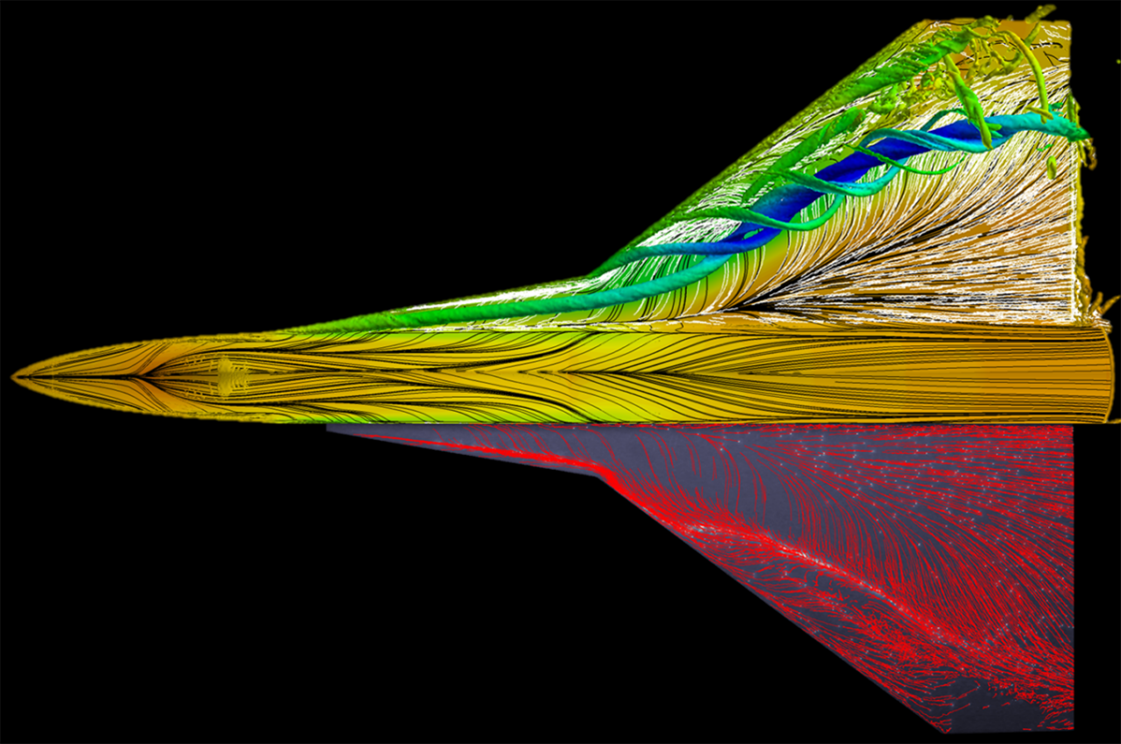- From 3–26 March 2026 (4 Weeks, 8 Classes, 16 Total Hours)
- Every Tuesday and Thursday at 1–3 p.m. Eastern Time (all sessions will be recorded and available for replay; course notes will be available for download)
- This new unique course focuses on the aerodynamic properties of vortex flows.
- All students will receive an AIAA Certificate of Completion at the end of the course.

OVERVIEW
Concentrated vortex flows are characterized by coherent
vorticity created from the highly swept edges of a lifting surface on an
aircraft. This coherent vorticity can be exploited to improve aerodynamic
performance, and such use of these flows is referred to as vortex-flow
aerodynamics. Key technical topics for the Vortex Flow Aerodynamics course
include concentrated vortex flow physics, aircraft applications of concentrated
vortex flows, CFD methodologies for simulating concentrated vortex flows, a state-of-the-art
assessment for prediction of concentrated vortex flow aerodynamics, and
opportunities to advance the understanding of and simulation confidence for
concentrated vortex flow aerodynamics. The course will touch upon an approach
that merges a physics-based perspective of the concentrated vortex flows with a
systems engineering viewpoint of the air vehicle.
LEARNING OBJECTIVES
- Grasp the uses of concentrated vortex flows for aircraft aerodynamics
- Comprehend the fundamental flow physics and properties of concentrated vortex flows
- Discern the strengths and weaknesses for simulation of concentrated vortex flows from a hierarchy of computational fluid dynamic techniques
- Become aware of opportunities for new research to improve the ability to use concentrated vortex flows for vehicle aerodynamics
AUDIENCE
This course is intended for holders of a
BS degree in aeronautical/aerospace engineering who have had coverage of basic
aerodynamic subjects but who have not had any significant exposure to vortex
flow aerodynamics. These audience members might be new graduates or experienced
engineers who want to learn about the basic role concentrated vortex flows play
in aircraft aerodynamic performance. Course participants should be able to
perform basic Computational Fluid Dynamics simulations and/or basic wind tunnel
experimentation pertinent to aircraft aerodynamics, although these topics will
be reviewed within the course. Audience members with added interest in maneuver
aerodynamics and separated flow management can use this course to prepare for
those more advanced topics.
COURSE FEES (Sign-In
To Register)
- AIAA
Member Price: $945 USD
-
AIAA Student Member Price: $595 USD
- Non-Member Price: $1145 USD
--------------------------------------------------------------------------------------------
- Introduction - Scope of material, Learning objectives, Approach, Organization
- Terminology
- Concentrated vortex flow
- Modeling & Simulation (M&S)
- Verification & Validation (V&V)
- Systems engineering
- Aircraft Applications of Concentrated Vortex Flows
- Military
- Commercial
- Systems engineering and flow physics perspectives
- Elemental Flow Physics of Concentrated Vortex Flows
- Flow physics components
- Flow physics manifestations
- M&S Technology for Concentrated Vortex Flows
- Hierarchy of methods
- Consequences for concentrated vortex flows
- State of Art Assessment: Fundamental Vortical Flow Simulations
- Steady flows
- Unsteady flows
- State of Art Assessment: Configuration Application Capabilities
- Subcomponent-scale vortices
- Component-scale vortices
- Subsystem- and system-scale vortices
- Key Inferences from state-of-the-art assessment
- Fundamental vortical flow simulations
- Configuration applications
- Path Forward for Improved Understanding and Simulation of Concentrated Vortex Flows
- Context for simulation advancements
- Insights from new physical and numerical experiments
- M&S process Improvements
- Summary comments
- Concluding Remarks
INSTRUCTORS
Dr. Arthur (Art) Rizzi is an Emeritus Professor of Aeronautics and one of the founding members of the Center for Computational Mathematics and Mechanics at KTH. From 2006-2010 he was the Coordinator for the EU-Funded Framework 6 Project SimSAC: Simulating Aircraft Stability and Control Characteristics for use in Conceptual Design. Dr. Rizzi is a graduate of Stanford University where he earned his M.S. and Ph.D. degrees in Applied Mechanics; his B.S. degree is from the Pennsylvania State University. He currently serves on the Board of Editors for the journal Progress in Aerospace Sciences. He is co-author of the monograph Separated and Vortical Flow in Aircraft Wing Aerodynamics and lead author of the textbook Aircraft Aerodynamic Design with Computational Software. Dr. Rizzi has previously worked in the Computational Fluid Dynamics Branch of NASA Ames Research Center, and in the Aerodynamics Department of the Aeronautical Research Institute of Sweden (FFA). He is an Associate Fellow of the American Institute of Aeronautics and Astronautics and a Fellow of the Institute of Mathematics and its Applications.
Classroom Hours / CEUs: 16 classroom hours, 1.6 CEU/PDH
Course Delivery and Materials
- The course lectures will be delivered via Zoom.
- All sessions will be available on-demand within 1-2 days of the lecture. Once available, you can stream the replay video anytime, 24/7. All slides will be available for download after each lecture.
- No part of these materials may be reproduced, distributed, or transmitted, unless for course participants. All rights reserved.
- Between lectures, the instructors will be available via email for technical questions and comments.
Cancellation Policy: A refund less a $50.00 cancellation fee will be assessed for all cancellations made in writing prior to 7 days before the start of the event. After that time, no refunds will be provided.
Contact: Please contact Lisa Le or Customer Service if you have questions about the course or group discounts (for 5+ participants).